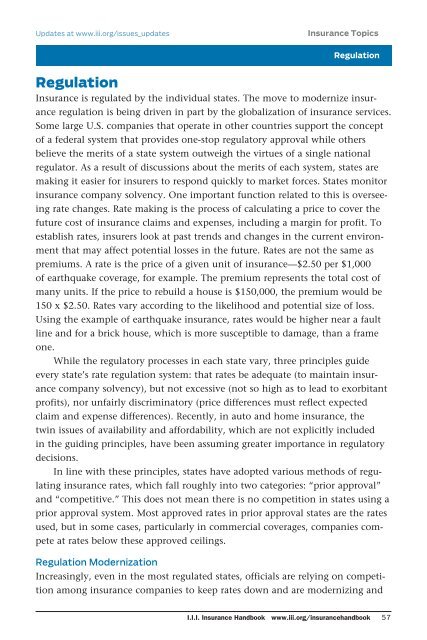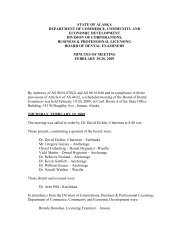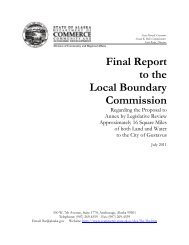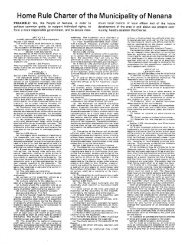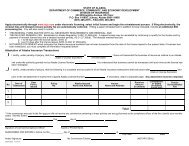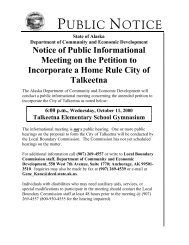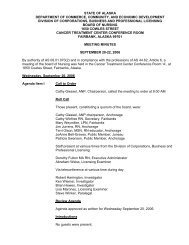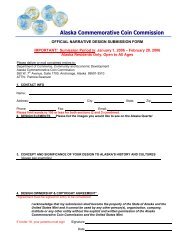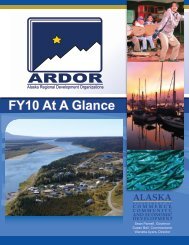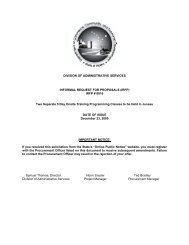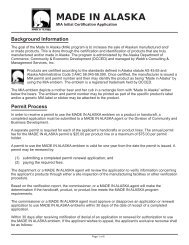Insurance Handbook - Alaska Department of Community and ...
Insurance Handbook - Alaska Department of Community and ...
Insurance Handbook - Alaska Department of Community and ...
Create successful ePaper yourself
Turn your PDF publications into a flip-book with our unique Google optimized e-Paper software.
Updates at www.iii.org/issues_updates <strong>Insurance</strong> Topics<br />
Auto Regulation<br />
<strong>Insurance</strong><br />
Regulation<br />
<strong>Insurance</strong> is regulated by the individual states. The move to modernize insurance<br />
regulation is being driven in part by the globalization <strong>of</strong> insurance services.<br />
Some large U.S. companies that operate in other countries support the concept<br />
<strong>of</strong> a federal system that provides one-stop regulatory approval while others<br />
believe the merits <strong>of</strong> a state system outweigh the virtues <strong>of</strong> a single national<br />
regulator. As a result <strong>of</strong> discussions about the merits <strong>of</strong> each system, states are<br />
making it easier for insurers to respond quickly to market forces. States monitor<br />
insurance company solvency. One important function related to this is overseeing<br />
rate changes. Rate making is the process <strong>of</strong> calculating a price to cover the<br />
future cost <strong>of</strong> insurance claims <strong>and</strong> expenses, including a margin for pr<strong>of</strong>it. To<br />
establish rates, insurers look at past trends <strong>and</strong> changes in the current environment<br />
that may affect potential losses in the future. Rates are not the same as<br />
premiums. A rate is the price <strong>of</strong> a given unit <strong>of</strong> insurance—$2.50 per $1,000<br />
<strong>of</strong> earthquake coverage, for example. The premium represents the total cost <strong>of</strong><br />
many units. If the price to rebuild a house is $150,000, the premium would be<br />
150 x $2.50. Rates vary according to the likelihood <strong>and</strong> potential size <strong>of</strong> loss.<br />
Using the example <strong>of</strong> earthquake insurance, rates would be higher near a fault<br />
line <strong>and</strong> for a brick house, which is more susceptible to damage, than a frame<br />
one.<br />
While the regulatory processes in each state vary, three principles guide<br />
every state’s rate regulation system: that rates be adequate (to maintain insurance<br />
company solvency), but not excessive (not so high as to lead to exorbitant<br />
pr<strong>of</strong>its), nor unfairly discriminatory (price differences must reflect expected<br />
claim <strong>and</strong> expense differences). Recently, in auto <strong>and</strong> home insurance, the<br />
twin issues <strong>of</strong> availability <strong>and</strong> affordability, which are not explicitly included<br />
in the guiding principles, have been assuming greater importance in regulatory<br />
decisions.<br />
In line with these principles, states have adopted various methods <strong>of</strong> regulating<br />
insurance rates, which fall roughly into two categories: “prior approval”<br />
<strong>and</strong> “competitive.” This does not mean there is no competition in states using a<br />
prior approval system. Most approved rates in prior approval states are the rates<br />
used, but in some cases, particularly in commercial coverages, companies compete<br />
at rates below these approved ceilings.<br />
Regulation Modernization<br />
Increasingly, even in the most regulated states, <strong>of</strong>ficials are relying on competition<br />
among insurance companies to keep rates down <strong>and</strong> are modernizing <strong>and</strong><br />
I.I.I. <strong>Insurance</strong> <strong>H<strong>and</strong>book</strong> www.iii.org/insuranceh<strong>and</strong>book 57


